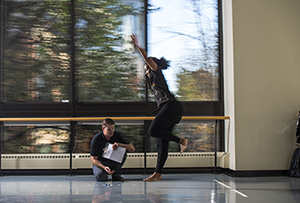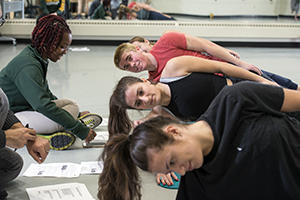Dance Medicine Program Thrives at Mason — and Beyond
March 20, 2019
Dancers’ medical needs, as athletes, have long been underserved. Jatin Ambegaonkar, an associate professor in the College of Education and Human Development, has made it his goal to change that.
It started when Ambegaonkar was an athletic trainer and worked with dancers. He found it to be a symbiotic relationship—“they were a group of aesthetic athletes who never really receive any kind of medical support,” he says—and he decided to pursue the field further.
That was more than a decade ago. Ambegaonkar has spent the past 12 years at Mason heading up its dance medicine program after helping create it in 2007. He is the founding co-director of the Sports Medicine Assessment Research and Testing (SMART) Laboratory and co-founded the South Asian Dance Medicine & Science Association.
His overarching goal is to improve the health, well-being, and fitness of dancers. Every year for the past decade at Mason, he has done that in part by conducting fitness assessments of dancers in the Mason Dance program.

The fitness assessments are a way for freshman dancers to get a good sense of where they are physically and to form a benchmark that could help them create activity plans or identify injury risks in advance.
One afternoon each fall, the dancers go through their background and medical history with researchers, and then are tested on their flexibility, strength, power, balance, cardiovascular responses to exercise, hypermobility status, core strength, and overall quality of life.
“It’s an overarching understanding of where the dancer is when they see us,” Ambegaonkar says. “And that really helps set the baseline norm for that dancer.”
During the spring semester of their senior year, the dancers return for another assessment, to see what has changed in the intervening years.
“We’re trying to really decrease injury risk, looking at these different factors, and to help them with their overall well-being so they continue to dance for as long as possible,” says Victoria Fauntroy, who has helped with the assessments.
Fauntroy is a graduate research assistant who won the 2018 Student Excellence Award from the Office of Student Scholarship, Creative Activities, and Research (OSCAR) for her work with Ambegaonkar.
Fauntroy graduated from the Athletic Training program last spring and has been dancing for 17 years. She had always been interested in pursuing dance medicine as a clinician. As a sophomore, she shared her interests with Ambegaonkar. He told her about how they can work to help dancers.
“He took me under his wing,” she says. “He’s been a great mentor—somebody that’s really helped me as a clinician, but also as a budding researcher.”
Fauntroy worked her first fitness assessment in the spring of 2017, helping the dancers acclimate to the exercises they need to complete, and keeping things fun while letting them know how much the assessment can help them in the long run. She says she’s learned a lot about administering tests and how each dancer reacts differently to different exercises.
Over the past few years, the researchers have come across some interesting trends. For example, dancers are more symmetrical than expected. The expectation may be that a dancer would have one leg that’s stronger than the other, but “they’re remarkably similar,” according to Ambegaonkar.
Ambegaonkar and his team are only able to identify trends of this sort through close collaboration with the dance program. For the past few years, Jena Hansen-Honeycutt, an athletic trainer in the School of Dance, has assisted with the fitness assessments.

“I think the students really do enjoy participating and pushing their limits for the day,” Hansen-Honeycutt says, adding that it’s important for the dancers to see that there are other people interested in helping them improve. The cross-disciplinary collaboration is beneficial to both the School of Dance and the College of Education and Human Development.
Ambegaonkar has worked to take the growing field of dance medicine—and fitness assessments—beyond just Fairfax. There are more than 450 collegiate dance programs in the United States, he says, but there has long been no unified common language for helping to assess dancers and prevent injuries. A common fitness assessment would support dancers in acheiving a long, healthy career.
He leads the Supporting Healthy Arts Research (SHARE) Consortium, which utilizes a common benchmark for fitness assessments across partner institutions. The goal is to begin to understand norms among dancers on a national level—to determine what dancers suffer from, and how to help them and reduce injury risk.
Now, six different universities are participating in the consortium, with another three or four set to join by the end of the year.
He’s also taken his passion for dance medicine international. In December, Ambegaonkar traveled to India to give a keynote lecture titled “Safe Dancers = Healthy Dancers: Dancers as Aesthetic Athletes” at the Indian Medical Association Hall in Juhu, Mumbai.
According to Ambegaonkar, there are between 30 and 40 million people regularly dancing in India but no formal dance medicine programs to treat dancers’ unique needs. In the past, it has been reductively simple: if you’re hurt, just rest up.
In his lecture, Ambegaonkar focused on strategies to keep dancers safe and healthy. His audience included dancers, teachers, choreographers, physical therapists, and doctors. Now, he says, there is awareness of dance medicine in India. That will help fuel further growth in this field.
“The itch has been scratched,” Ambegaonkar says.
